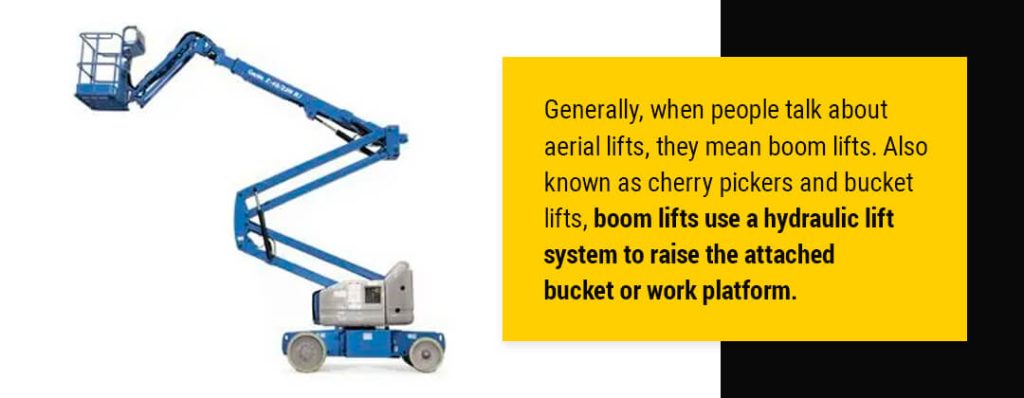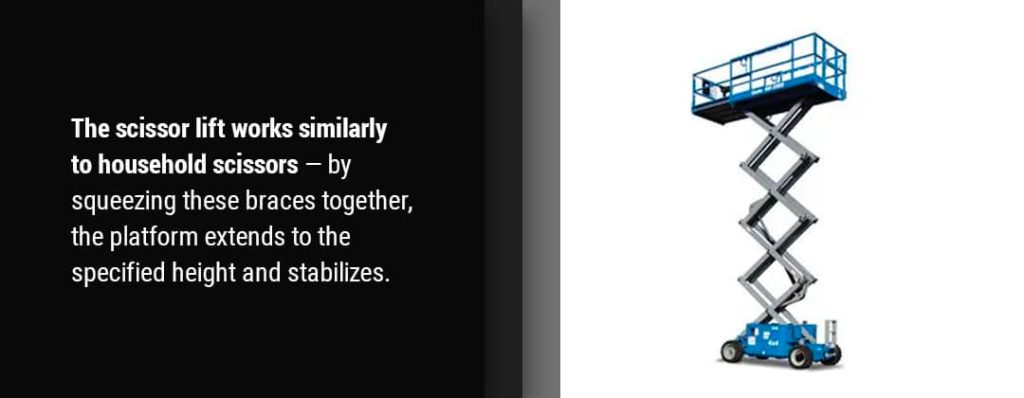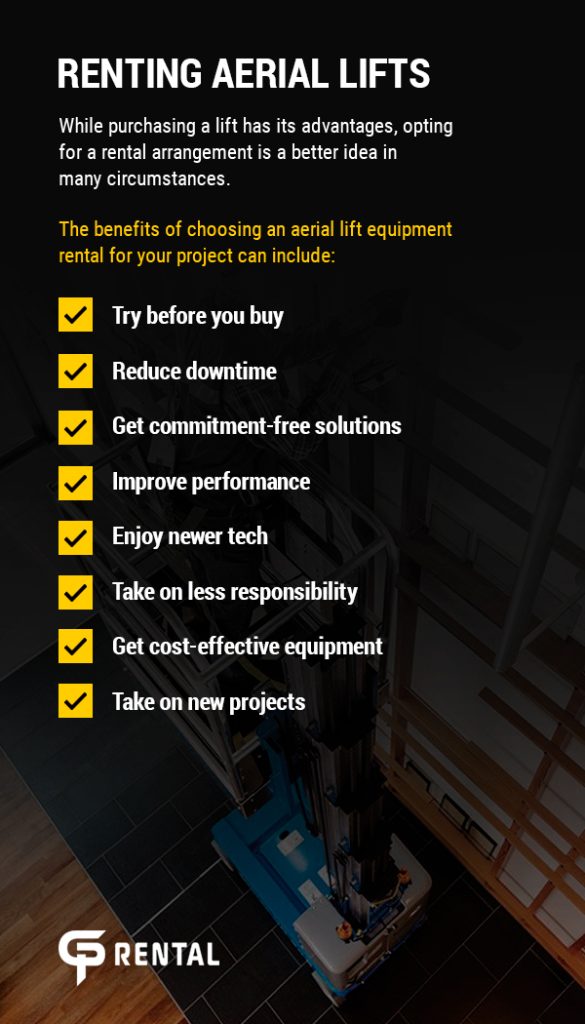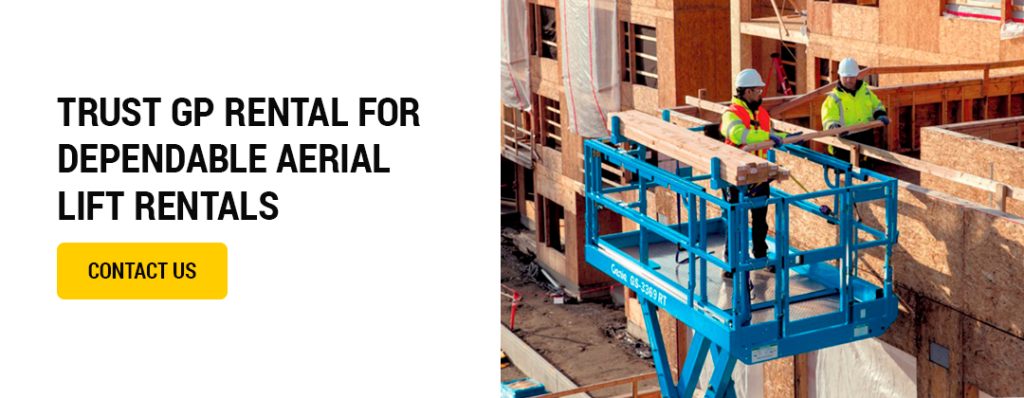Aerial lifts are versatile pieces of equipment that allow you to reach high work areas, like roofs, windows, treetops, ceilings and HVAC equipment. By providing a stable aerial platform, a lift offers the power and support your workers need to get the job done safely and efficiently.
This guide will explain the different types of aerial lifts, including common applications for each type. We’ll also discuss how to choose the right lift for your job site and the benefits of renting aerial lifts.
Different types of lifts serve different purposes. From reaching extreme heights to providing a safe work surface in challenging terrain, the type of lift you need will depend heavily on your application and your job site’s unique conditions.
There are three primary categories of aerial lifts:
Each type also has several subtypes, each of which is suitable for more specialized applications.

Generally, when people talk about aerial lifts, they mean boom lifts. Also known as cherry pickers and bucket lifts, boom lifts use a hydraulic lift system to raise the attached bucket or work platform.
There are two basic types of aerial lifts:
There are also specialized subtypes of boom lifts designed for specific applications, including:

Scissor lifts consist of a large, flat work platform set atop a system of interlocked braces. The lift works similarly to household scissors — by squeezing these braces together, the platform extends to the specified height and stabilizes.
Generally, scissor lifts can handle more weight than other lifts. Some models can handle up to six adults and their equipment. However, they also tend to be less maneuverable, with little capability for moving around obstacles.
Scissor lift subtypes include:
Also called man lifts, push arounds, personnel lifts or vertical mast lifts, vertical lifts are the smallest aerial lifts available. They tend to be lighter and more compact than scissor and boom lifts, making them ideal for getting through doors and other narrow pathways.
True to their name, vertical lifts extend straight up. Their maximum extended heights are usually lower than those of scissor or boom lifts, so consider your job requirements carefully.
Vertical lifts usually hold one person at a time due to their small size and narrow platforms, but some larger models can hold two or three people. Any job that requires more than that would benefit more from another type of lift.
Due to their light frame, vertical lifts are more practical for indoor work — wind or other environmental factors can impact the lift’s stability.
Typical uses for vertical lifts include:
While each aerial lift can serve multiple purposes, some are better suited for certain applications than others. When you’re deciding which type of lift to rent, account for the following factors.
Choosing a lift that can comfortably reach your work area is one of the most important considerations to make when deciding on a machine. There are two different measurements to pay attention to:
Mistaking these two measurements can leave you with a lift that is either too tall or too short for your job site. Additionally, a lift’s height may appear as a range or a single maximum value in a lift’s specifications, so keep dimensions in mind.
You should also consider any overhead obstacles that may make extending a lift difficult or unsafe. For example, if your project involves painting a hard-to-reach crevice of a ceiling, you’d be better off using an atrium lift with an articulated boom than a comparable straight telescopic boom lift that can only extend in one direction.
Certain types of aerial lifts have higher weight capacities than others. For example, if you need more than two or three workers on the platform at a time, a scissor or boom lift will serve you much better than any vertical lift.
While you’re evaluating different lifts, make a list of the weights of every worker and tool that will be on the platform. In some cases, an estimate will suffice, but accurate numbers are always ideal.
Pay close attention to the specifications — some lifts will have a personnel limit regardless of weight. Even if you’re well under the maximum weight, you still need to comply with the personnel limit to ensure employee safety.
If you’ve decided on a lift but the personnel limit may be a limiting factor for you, rearranging the work schedule might be a good idea. Instead of completing multiple tasks at once, break the work up so only the specified number of workers will be on the platform at once.
Accounting for your work environment is critical when choosing an aerial lift. Correctly matching your lift to your application ensures you will have the support and power you need to complete your work.
Important terrain factors include:
The type of power source your lift uses directly impacts your efficiency, which affects your bottom line. Some power sources are better suited for certain applications.
You’ll find the following fuel sources in aerial lifts:
The space you’ll be working in is also an important determinant in what power source you should choose. For example, diesel lifts are better suited for outdoor applications because they emit toxic fumes. While battery-powered lifts are safe for indoor use, you’ll have to ensure an outlet or additional batteries are available to ensure continuous power.
The features you need will depend on your specific application. Common aerial lift features include:
You may also want to look into additional accessories to enable greater efficiency while on the job. Some examples of attachments include:
Understanding your insurance responsibility is important when renting any piece of heavy equipment, including aerial lifts. Carefully read and review your entire rental agreement before you sign.
Typically, a rental dealer will cover the equipment, but your company can be held accountable for any operator injuries or property damage that happens while the equipment is in use. This arrangement can vary depending on the provider you choose to work with.
Bottom line — make sure you know where the dealer’s coverage ends and your insurance obligation begins.
To operate an aerial lift, you need someone who is familiar with best practices for aerial equipment safety. Even if someone on your team knows the basics, it’s best to choose an operator who can ensure your team follows all safety measures and enforces the lift’s maximum capacity.
If you still need someone to fill that role, your dealer may offer operator training, or they may be able to point you toward places you could go to find qualified operators.

While purchasing a lift has its advantages, opting for a rental arrangement is a better idea in many circumstances. The benefits of choosing an aerial lift equipment rental for your project can include:

At GP Rental, we’re proud to be your main lift rental in the eastern North Carolina region. We keep our low-hour rental equipment well-maintained, so it’s always ready to perform at peak capacity. We offer a variety of Genie aerial lifts, including scissor, vertical, articulating and straight boom models.
Browse our online selection of rental lifts to see what we have available, or find your nearest location here.
Still have questions? We’re here to help. Contact us for more information today.